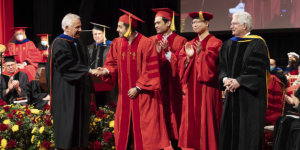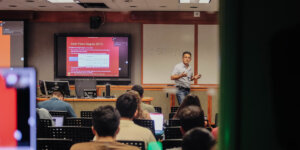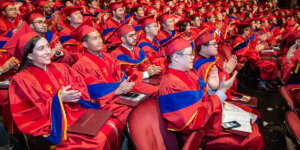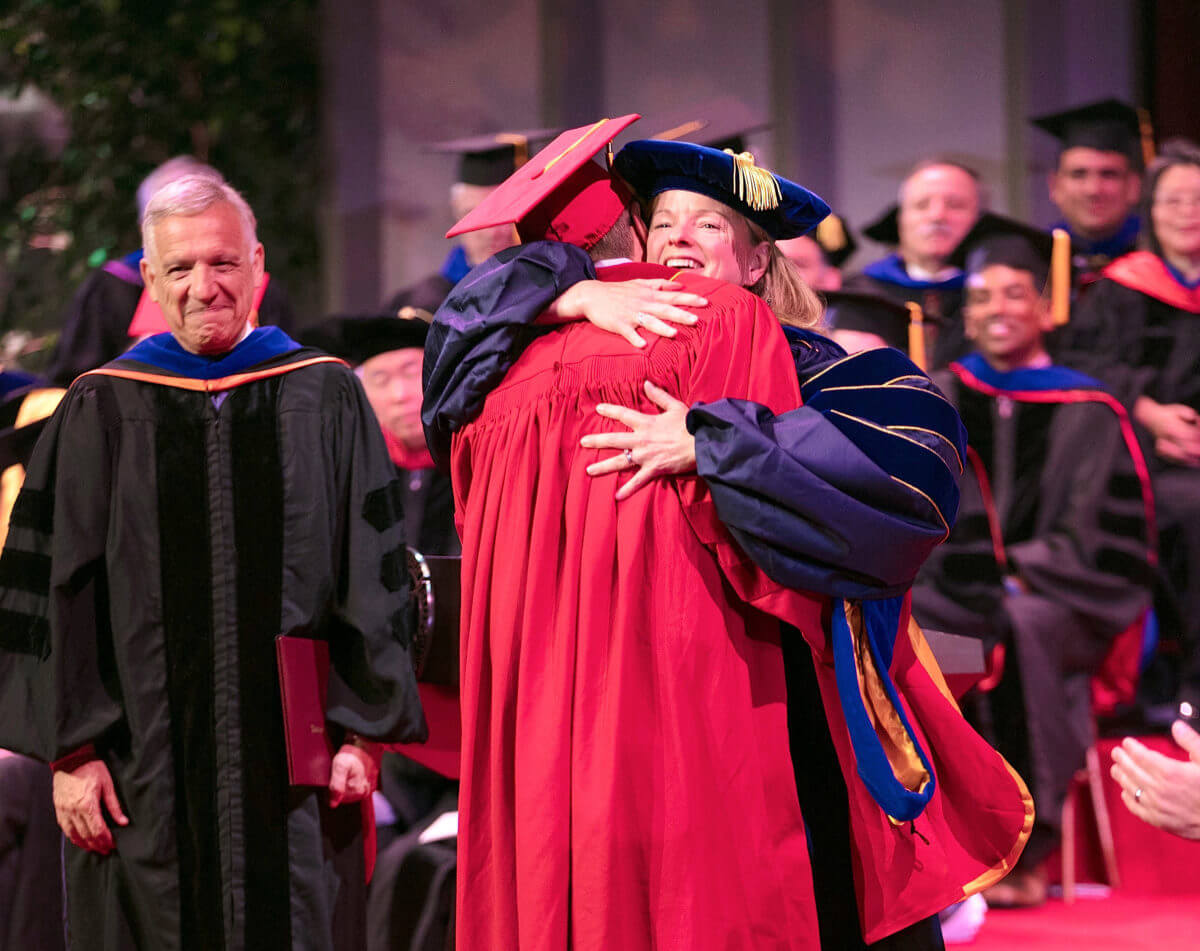
Professor Amy Childress embraces one of her newly hooded Ph.D.s at the 2018 USC Viterbi Ph.D. Hooding and Awards ceremony at Bovard Auditorium. PHOTO: Victor Leung.
Marie Curie’s Ph.D. thesis in 1903 won her the first of two Nobel Prizes and changed everything we knew about radioactive materials.
K. Eric Drexler’s 1991 Ph.D. dissertation changed the way we imagined building very small things – using tiny nano-sized robots that could build almost anything by manipulating atoms and molecules.
Fast forward to 2018 at USC’s Bovard Auditorium.
At the 2018 USC Viterbi Ph.D. Hooding and Awards ceremony, 160 newly hooded Ph.D.s of the USC Viterbi School of Engineering joined a very select group.
Said Dean Yannis C. Yortsos, USC Viterbi dean: “According to the most recent U.S. census data, just over 1 percent of the U.S. population holds a Ph.D. One of them, by the way, is a fellow by the name of Andrew Viterbi, who just over 50 years ago created the Viterbi Algorithm – the “killer app” behind digital communications, voice recognition and DNA sequencing among others.”
Yortsos saluted the assembled Ph.D.s, urging them to continue their pursuit of “heroic engineering.”
“I think there is something heroic in devoting yourself to the pursuit of new knowledge,” said Yortsos, “to take the frontier of what is known and say, ‘I’m going beyond this point.’”
Some of those pioneers include this year’s finalists of the best USC Viterbi Ph.D. dissertation award for 2018 – the William F. Ballhaus, Jr. Prize for Excellence in Graduate Engineering Research.
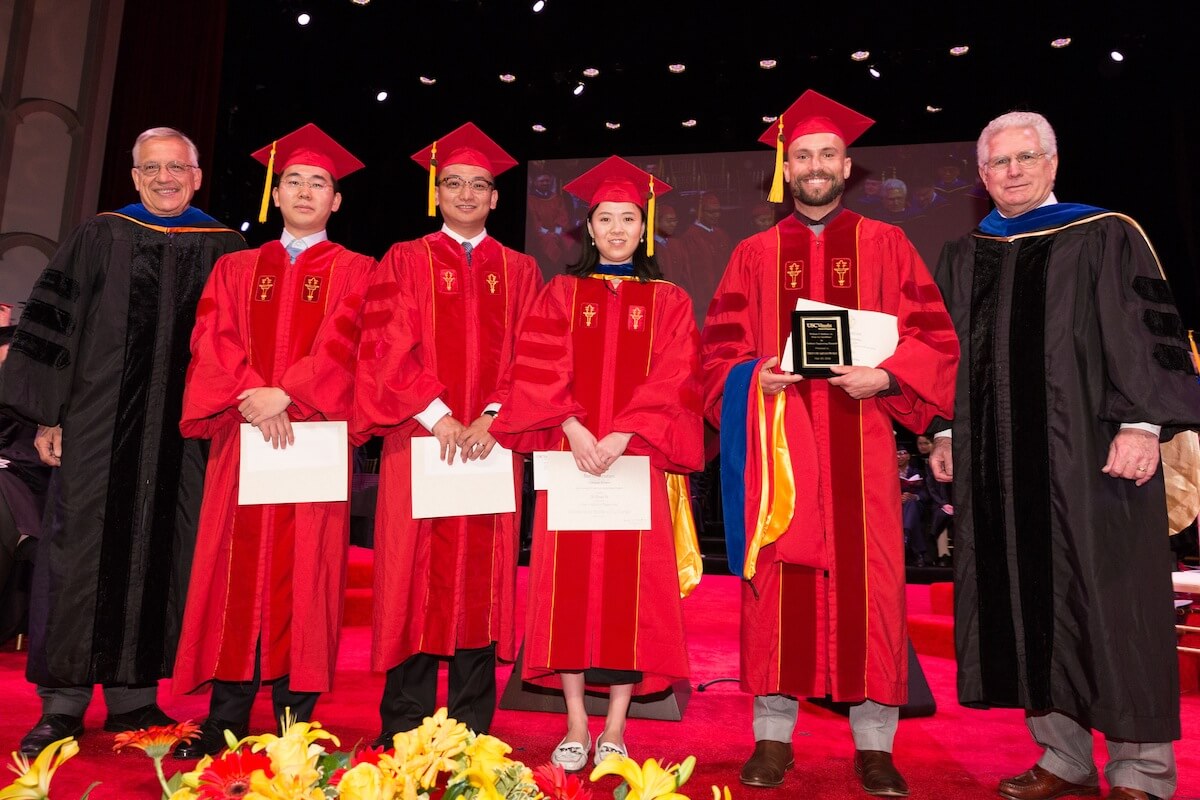
Finalists for the 2018 William F. Ballhaus, Jr. Prize for Excellence in Graduate Engineering Research: (hooded, from left to right) Chenfei Shen, Yuankun Xue, Rose Yu and Trevor Krasowsky (winner). They are joined by Dean Yannis Yortsos (far left) and award namesake, William Ballhaus, Jr. (far right). PHOTO: Victor Leung
Rose Yu, who is starting as an assistant professor at Northeastern University in the fall, creates algorithms “to make computers learn like humans.”
One of her previous papers, published in 2014, was honored among the top 2 percent at Neural Information Processing Systems, or NIPS, the world’s “largest and most influential AI conference.” She also lead outreach efforts to female researchers in machine learning, co-organizing the NIPS Women in Machine Learning Workshop.
Said Professor Yan Liu, Yu’s faculty adviser in the USC Melady Lab, “She is never afraid of pushing the frontiers, exploring new opportunities, and making mistakes and learning from it.”
Currently a post-doctoral researcher at Caltech, Yu’s work in AI and machine learning has implications for self-driving cars like Waymo – formerly the Google self-driving car project –, which now seeks testing of fully driverless cars in California.
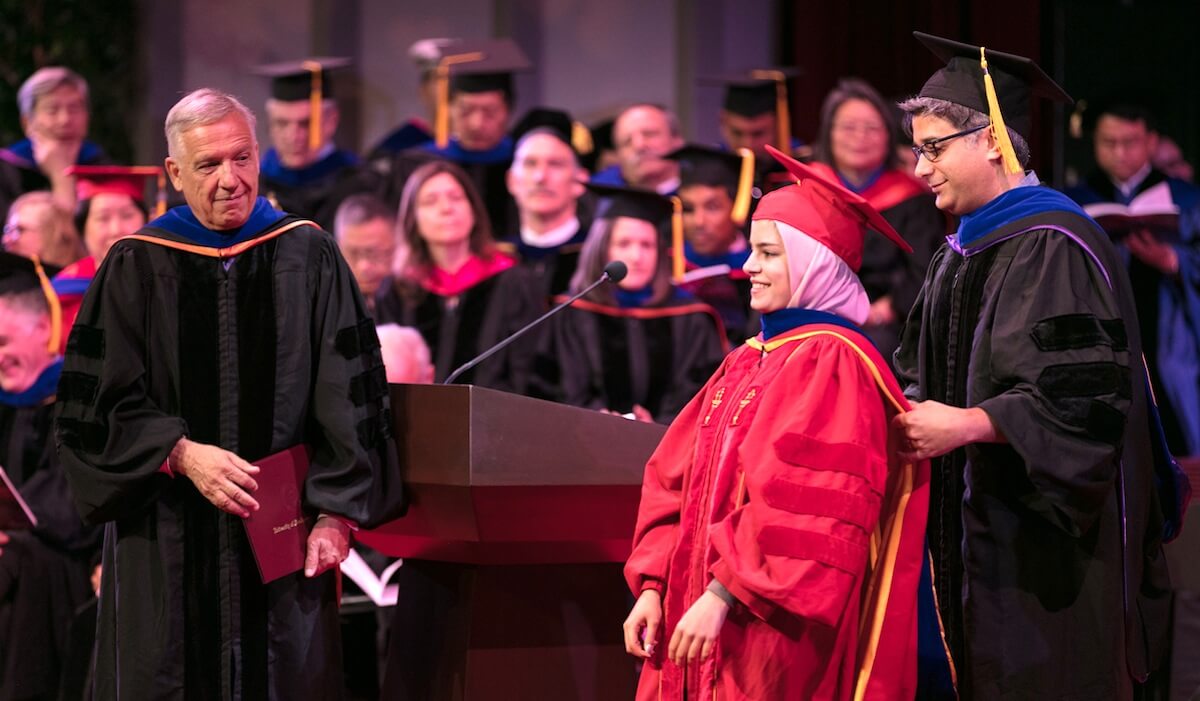
Reihane Boghrati receives her Ph.D. hood from faculty adviser, Morteza Dehghani. PHOTO: Victor Leung
Ballhaus Prize winner, Trevor Krasowsky, on the other hand, looks at air pollutant emissions from sources such as transportation. Specifically, the climate and health issues raised by black carbon particles: basically, soot in the air – produced by diesel engines, coal power plants and biomass burning.
He currently aids scientists and policy-makers with the California Air Resources Board, exposing the role of black carbon in warming our planet. He likens it to a global “black T-shirt on a sunny day” that soaks up heat and mingles with volatile compounds in the air. His Ph.D. work was under the direction of Assistant Professor George Ban-Weiss, who was named one of MIT Technology Review’s top 35 global innovators under age 35 in 2014.
Said Ban-Weiss: “Trevor’s research can inform policies that are aimed at effectively reducing cancer risk and climate impacts of diesel pollution. Perhaps the most satisfying aspect has been seeing him take the knowledge gained through his dissertation and devising research projects at his new job at California Air Resources Board with the aim of creating science-backed policies that reduce human health risks associated with air pollution exposure.”
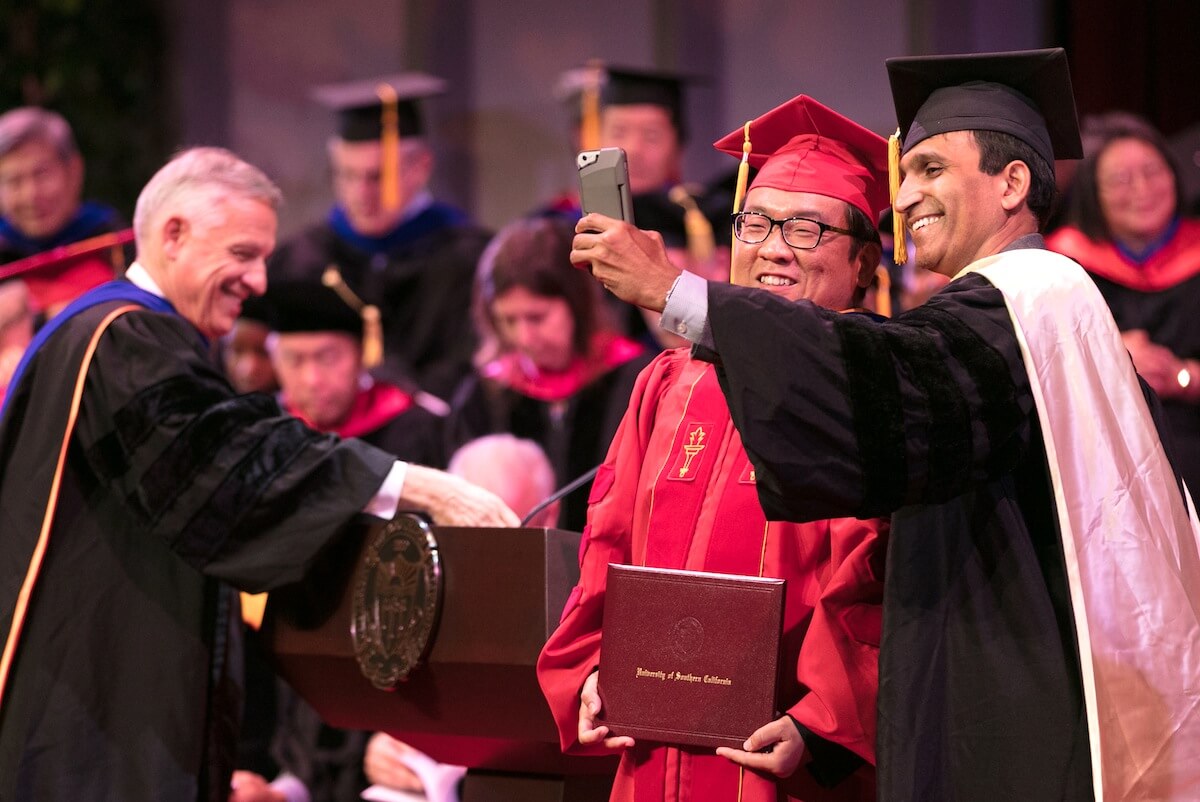
Professor Murali Annavaram snaps a selfie with newly hooded Ph.D., Gunjae Koo. PHOTO: Victor Leung.
Yuankun Xue already had his dream job as a Tokyo-based researcher for Panasonic. One day, something popped up in his e-mail: an American professor had posted a research challenge. That professor, USC Viterbi’s Paul Bogdan, was working on a radical idea – using networks-on-chip to compute the 3-D structure of large protein molecules and diagnose some of our most feared illnesses like cancer, Huntington’s and Parkinson’s early in their nascent states.
Xue quit his job to come to USC and build a translator – how is the physical world talking to itself? How do the cells in our bodies, neurons, viruses communicate with one another? And if you learned this language, could you “train an army of good viruses to deliver drugs inside our body to attack the bad ones?”
Said Bogdan, his Ph.D. adviser: “Yuankun’s research intertwines the electrical and computer engineering disciplines; it allows us to analyze and self-correct social democracy by identifying malicious attacks on elections; it also enables us to detect hidden interactions in biological systems that could lead to catastrophic diseases. His Ph.D. work is unique and has deep implications.”
Next, Xue heads to Mountain View to lead a team at Synopsys “to empower chip design with machine learning engines.”
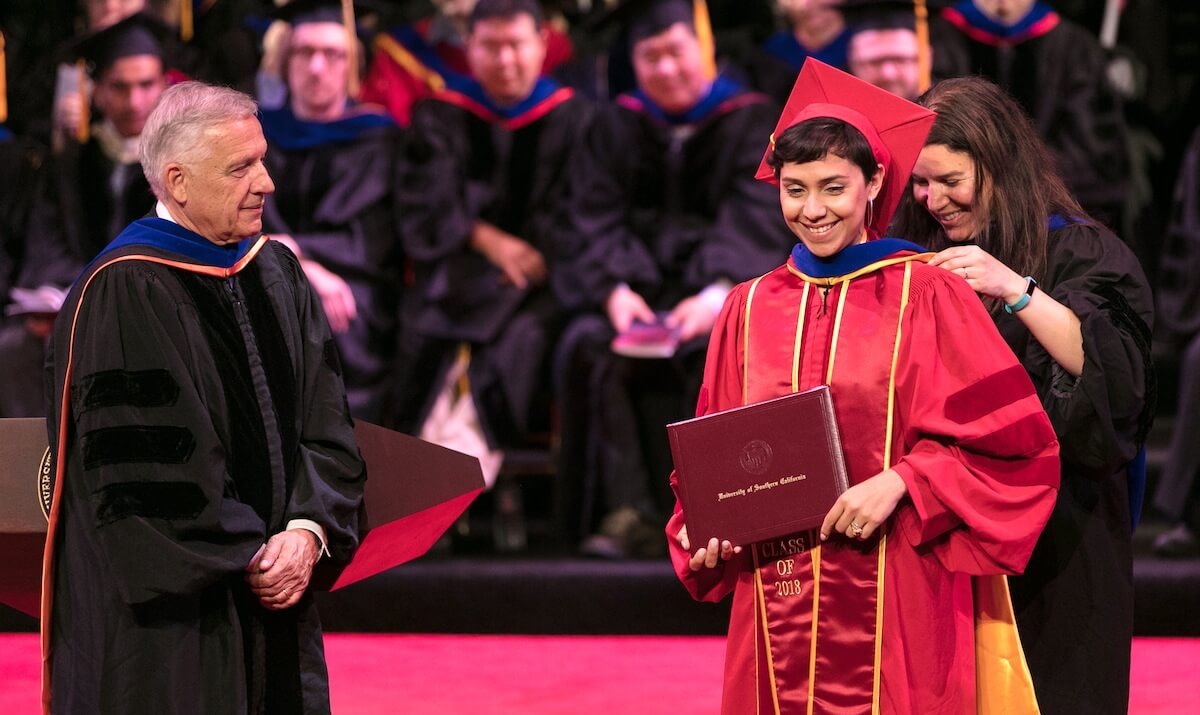
Professor Andrea Hodge hoods new Ph.D., Theresa Juarez. PHOTO: Victor Leung
Chenfei Shen is re-imagining the batteries that power our modern world, from Apple’s iPhones to Tesla’s electric cars. Using a novel combination of silicon and sulfur, Shen has demonstrated a potential battery with “more than three times the theoretical capacity of commercially available lithium‑ion batteries.”
Shen took his childhood love of LEGOs and dream of becoming an architect to become a builder of very small things. As a member of Professor Chongwu Zhou’s Nano Lab, Shen loved the feeling of running his experiments until midnight and then returning home through “the peaceful and beautiful campus” and feeling that “all the hard work during the day is rewarding.”
Shen begins work at Applied Materials, a Silicon Valley semiconductor company, in June.
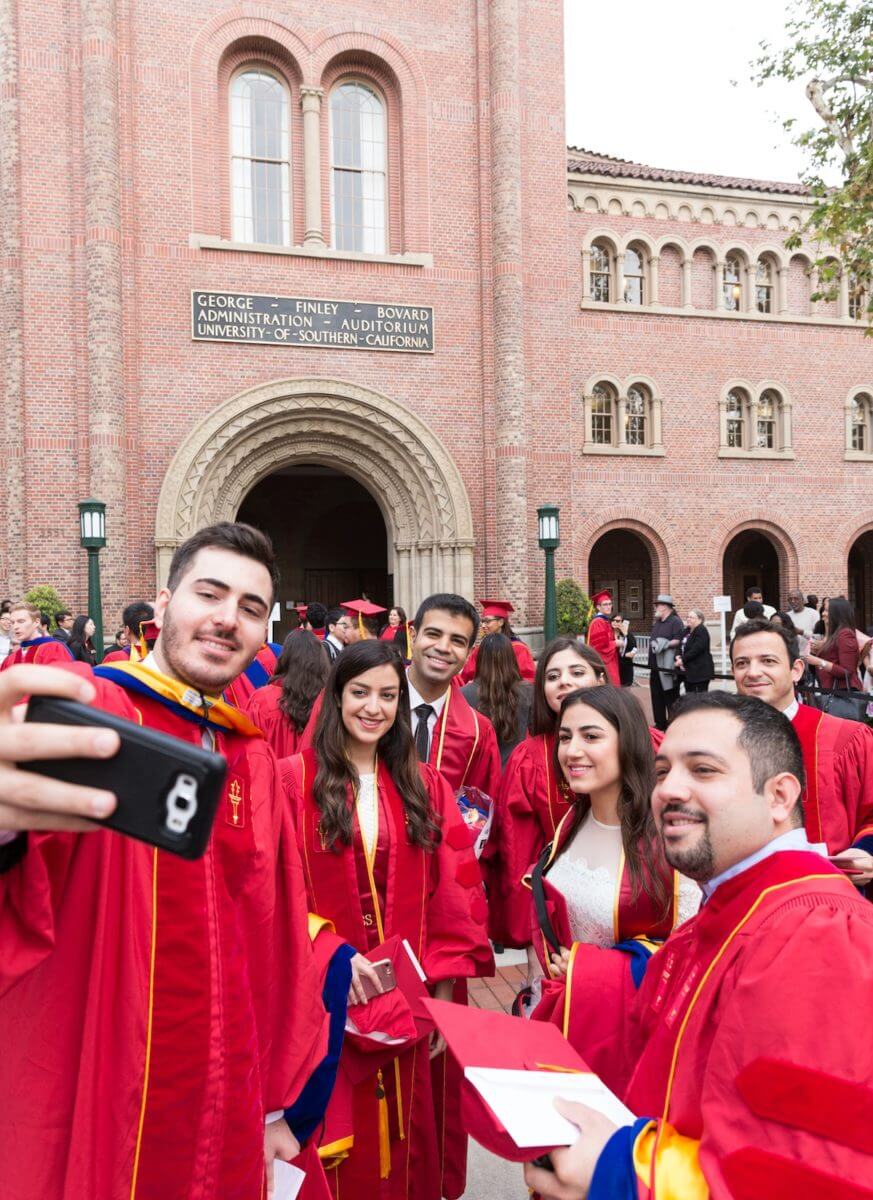
New doctors of philosophy, Ph.D.s, at the USC Viterbi School of Engineering celebrate outside Bovard Auditorium. PHOTO: Victor Leung
View more photos from ceremony here.
Here are the 2018 winners of distinguished Ph.D. awards:
BEST DISSERTATION
Department of Aerospace and Mechanical Engineering
Bo Cheng Jin
Development of Composite Oriented Strand Board and Structures
Department of Astronautical Engineering
Randall Hughes
Particle-in-cell Simulations of Kinetic-scale Turbulence in the Solar Wind
Department of Biomedical Engineering
Leonardo Nava Guerra
Model-Based Phenotyping of Obstructive Sleep Apnea in Overweight Adolescents for Personalized Theranostics
Epstein Department of Industrial and Systems Engineering
Yalda Khashe
Human and Organizational Factors of PTC Integration in Railroad System and Developing HRO-centric Methodology
for Aligning Technological and Organizational Change
Mork Family Department of Chemical Engineering and Materials Science
Sahar Bakhshian
Chemical and Mechanical Deformation of Porous Media and Materials During Adsorption and Fluid Flow
Chenfei Shen*
Nanomaterials for Energy Storage Devices and Electronic/Optoelectronic Devices
Sonny Astani Department of Civil and Environmental Engineering
Subhayan De
A Novel Hybrid Probabilistic Framework for Model Validation
Trevor Krasowsky**
Characterization of Black Carbon: From Source to Evolution of Physical and Optical Properties in the Atmosphere
Department of Computer Science
Qi (Rose) Yu*
Tensor Learning for Large-Scale Spatiotemporal Analysis
Ming Hsieh Department of Electrical Engineering
Shao-Hua Wu
Light Matter Interactions in Engineered Structures: Radiative Thermal Management & Light-Assisted Assembly of Reconfigurable Optical Matter
Hao Yu
New Lagrangian Methods for Constrained Convex Programs and Their Applications
Yuankun Xue*
Theoretical and Computational Foundations for Cyber-Physical Systems Design
* finalist, William F. Ballhaus, Jr. Prize for Excellence in Graduate Engineering Research
**winner, William F. Ballhaus, Jr. Prize for Excellence in Graduate Engineering Research
BEST RESEARCH ASSISTANT
Department of Aerospace and Mechanical Engineering
Abbasali Davani Davari
Department of Astronautical Engineering
Yuan Hu
William Yu
Department of Biomedical Engineering
Ahuva Weltman Hirschberg
Mork Family Department of Chemical Engineering and Materials Science
Boju Gai
Sonny Astani Department of Civil and Environmental Engineering
Qin Ba
Seyyed Farshid Hosseini Khasheh Heiran
Mahsa Moslehi
Department of Computer Science
Yaguang Li
Arman Shahbazian
Yixue Zhao
JENNY WANG EXCELLENCE IN TEACHING AWARD
Department of Astronautical Engineering
Brian Anderson
Department of Biomedical Engineering
Xuejun Qian
Mork Family Department of Chemical Engineering and Materials Science
Xiaoxi Zhao
Sonny Astani Department of Civil and Environmental Engineering
Lauren Crawford
Department of Computer Science
Yixue Zhao
Ming Hsieh Department of Electrical Engineering
Olaoluwa (Oliver) Adigun
Daniel J. Epstein Department of Industrial and Systems Engineering
Santiago Carvajal
MING HSIEH INSTITUTE SCHOLARS
Ming Hsieh Department of Electrical Engineering
Divya Varadarajan
Xiaohan Wei
Yihang Liu
Long Li
Viterbi Undergraduate Research Mentoring Award
Ashrant Aryal
UNIVERSITY AWARDS
Ph.D. Achievement Award
Niki Bayat
Published on May 10th, 2018
Last updated on January 7th, 2021





